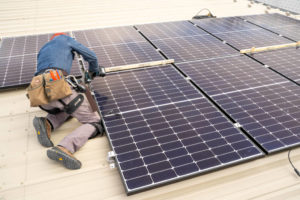Choosing metal roofs for solar photovoltaics

Metal roofing is also resistant to fire, weather, and climate conditions due to its sturdy and inert composition. It is non-combustible and will not ignite during a wildfire or lightning strike, which may help save on insurance premiums. Metal roofing over open structural framing is a Class A (UL 790) material with respect to burning brand flame spread. Over wood decking with fire retardant underlayment is also accepted by Underwriters Laboratories (UL) and approved as Class A.
Ultraviolet (UV) rays and temperature changes fatigue most roof types with constant thermal expansion and contraction, while modern SSMRs respond to temperature changes freely and without fatigue. Metal is inert and impervious to UV degradation, which embrittles other materials. Premium factory finishes of polyvinylidene fluoride (PVDF) paint films offer up to 40-year warranties against excessive fade, chalk, and film integrity. Further, because metal panels have structural characteristics, they can be designed to resist virtually any wind speed, including Category 5 hurricane winds.
In addition, because of the maintenance freedom afforded by metal roofs, owners are not faced with costly roof upkeep, patching, and repair. Alternative roofing materials with much shorter life spans have more intense maintenance requirements and high repair, tear-off, and replacement costs—offering little advantage over metal products other than the initial cost.
Most alternative roofing types will expire long before the life of the PV system. The costly expenses associated with the disassembly of the PV array, re-roofing and re-assembly erode the otherwise attractive financial metrics of roof-mounted PV. High-end tile may be the only exception to re-roofing, but its price tag is similar to standing seam metal roofing. Mounting solar to tile is invasive and can be very tricky to do without breaking tiles, hence the cost is also much higher than mounting to metal.
The roof and PV should be considered a single asset. When all the facts are known, the standing seam metal roof is the only roof type worthy of consideration for solar PV, with face-attached metal profiles being a close second.
Ease of installation
It is easier and less expensive to mount solar to a metal roof than any other roof type.
The uniqueness of metal roofing is how the structural ribs or seams can be used as inherent (and cost-free) “rails” for mounting solar PV via reliable mechanical attachments, so the need for a traditional rail system is eliminated, saving cost, weight, and logistics.
Direct attachment of solar modules to a metal roof can be accomplished with fewer components and lightweight materials, resulting in better load distribution and zero penetration, which preserves the integrity of the roof, as well as the roof manufacturer’s warranty.
Since there is no rail structure needed, the material required for a mounting system is reduced by weight (85 per cent), volume (90 per cent) and savings on hard goods (up to 35 per cent). This also reduces the carbon footprint. At only 15 per cent of the weight and 10 per cent of the volume of rail mountings, the energy consumed in production and transportation is reduced by the same ratios.
The key to labour savings (30 to 50 per cent) is the simplicity of rail-less attachment: requiring 65 to 75 per cent fewer components, roof clamps are aligned and installed as modules are installed “on-the-fly” using the “rails” inherent to the SSMR.
Finally, shipping long lengths of rail to project sites and transporting them up to a rooftop is costly and often a logistical nightmare. With rail-less attachments, shipping costs for the mounting system can be 60 per cent lower than railed mounting systems, with fewer logistical hassles transporting the product to distribution, then the site, and then within the site and onto the roof. A traditional rail system of 750 kW would normally require a semi-truck to transport; while the same rail-less attachment solution would fit easily in a short-bed pickup truck.
Whether railed or rail-less, the simplicity and cost saving element of mounting to a metal roof are significant, and the future need for roof replacement is avoided.


